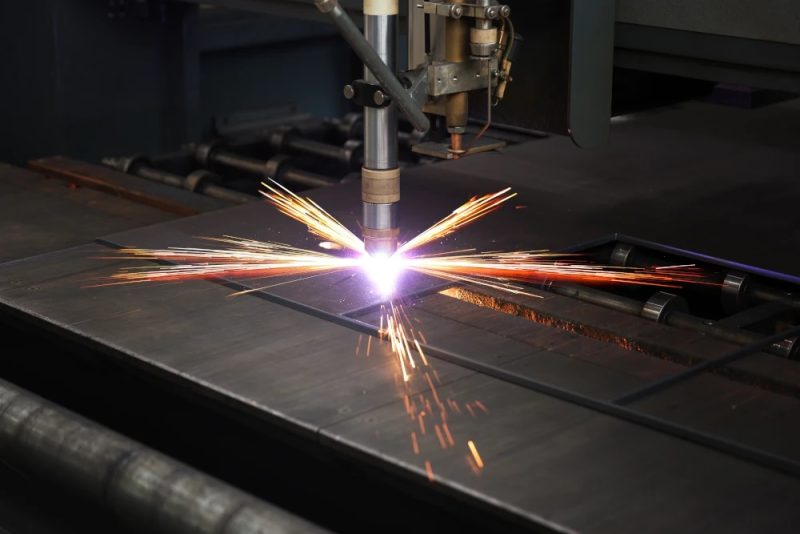The choice of cutting technology is crucial in shaping the efficiency, cost-effectiveness, and overall quality of manufactured products. Laser cutting stands out as a formidable alternative to conventional cutting methods like mechanical, water jet, and plasma cutting. In this blog, we’ll delve into the stark contrasts between laser cutting and traditional techniques, underscoring the distinct advantages of laser cutting. These benefits are why it has become the preferred solution across diverse industries, driving significant advancements in manufacturing precision and productivity.
Understanding Traditional Cutting Methods
Traditional cutting methods, such as mechanical cutting, water jet cutting, and plasma cutting, have been the backbone of manufacturing for decades. Mechanical cutting involves physical tools coming into contact with material to make cuts. This includes the use of saws, shears, and routers. Water jet cutting uses high-pressure water, sometimes mixed with an abrasive substance, to cut hard materials like metal and stone. Plasma cutting, on the other hand, uses a plasma torch to cut through electrically conductive materials by means of an accelerated jet of hot plasma.
What is Laser Cutting?
Laser cutting is a modern manufacturing technique that uses a high-powered laser beam to precisely cut or engrave materials into custom shapes and designs. The process begins with directing the laser beam through a nozzle to the workpiece. A combination of heat and pressure creates a clean and precise cut with exceptional accuracy.
The laser itself is generated in a laser source, commonly referred to as a laser resonator, and transmitted through a series of mirrors or fiber optics to the cutting head. Here, a lens focuses the laser to a very fine point on the material surface, melting, burning, or vaporizing the material away. Depending on the material and the specific requirements of the project, different types of lasers—such as CO2, Nd:YAG, or fiber lasers—are used.
The Advantages of Choosing Laser Cutting Over Traditional Cutting Methods
Choosing laser cutting over traditional cutting methods offers significant advantages, including precision and efficiency. This method has revolutionized how manufacturers approach cutting tasks, not only allowing for faster production times and reduced material waste but also enables the execution of complex cuts and intricate designs that are difficult or impossible with conventional methods.
Precision
One of the standout features of laser cutting is its precision. The laser beam used in laser cutting is focused to a pinpoint, allowing for incredibly precise cuts with clean, smooth edges. This level of accuracy is essential when working on intricate designs and detailed patterns. Traditional methods, while effective for broader cuts, often struggle with the complexity and finesse required in modern designs.
For example, when cutting complex shapes in sheet metal, traditional methods like mechanical cutting can lead to material wastage and require additional finishing steps to smooth out rough edges. Laser cutting, in contrast, achieves a high-quality finish in a single pass without the need for further processing.
Speed
Laser cutting is not only precise but also significantly faster than most traditional methods. The speed of laser cutting is especially noticeable when processing large batches of materials. This increased efficiency translates directly into cost savings and quicker turnaround times, making laser cutting an ideal choice for both high-volume industrial manufacturing and custom, one-off projects.
Versatility
Another significant advantage of laser cutting is its versatility. A single laser cutting setup can handle a variety of materials, including metals, plastics, wood, glass, and even paper, without the need for changing tools or settings. This contrasts with traditional methods, where different materials require different techniques and tools, each with its own set of limitations and setup times.
Laser cutting also offers greater flexibility in handling different material thicknesses and is gentler on the material, reducing the likelihood of damage during the cutting process. This is particularly important for delicate materials like thin metals or specialty composites.
Safety
Safety is crucial in any manufacturing process. Laser cutting reduces the risk of accidents typically associated with traditional cutting methods, which involve physical contact between machinery and material. Since laser cutting is a non-contact process, it minimizes the risks associated with blade entanglement or kickback. Furthermore, laser cutting machines are generally enclosed, significantly reducing the operator’s exposure to moving parts and cutting elements.
Additionally, laser cutting is a more environmentally friendly option. It produces less waste and, unlike some traditional methods, does not require the use of water or abrasive materials, which can lead to pollution and additional waste disposal issues.
Customization and Reproducibility
The ability to quickly and easily adjust laser settings for different materials and designs is another area where laser cutting shines. This flexibility allows for high levels of customization without compromising on speed or cost. Moreover, once a design is programmed, the laser cutter can reproduce it perfectly multiple times, ensuring consistency across production runs which is often more challenging with traditional cutting methods.
Affordability
Over time, laser cutting can be more cost-effective due to lower labor costs, reduced waste, and faster production times, making it a financially viable option. Additionally, the minimal maintenance requirements and the reduction in the need for secondary processing further decrease overall expenses, contributing to a lower total cost of ownership.
No Toxic Chemicals
Unlike some traditional cutting methods, laser cutting does not require the use of toxic chemicals, making it a safer and more environmentally friendly option. This not only helps in maintaining a healthier workplace but also reduces the environmental impact associated with the disposal of hazardous waste.
Applications Across Industries: The Versatility of Laser Cutting
Laser cutting is a versatile and precise method of cutting materials that is widely used across various industries. Each sector benefits from the unique advantages of laser cutting technology, such as high precision, speed, and the ability to handle complex designs. Here’s how laser cutting plays a crucial role in different industries, including aerospace, automotive, commercial, industrial, medical, and military and defense.
Aerospace and Space
In aerospace and space sectors, laser cutting is critical for producing components with extremely tight tolerances required for safety and functionality. It allows for the creation of lightweight structures from materials like titanium and aluminum, crucial for optimizing fuel efficiency and payload.
Automotive
The automotive industry uses laser cutting for its design flexibility and production speed, essential for crafting complex parts like engine components and decorative inlays. This technology supports the production of lightweight, high-strength vehicles at high volumes.
Commercial
Commercial applications of laser cutting include the production of intricate designs in signage, furniture, and architectural details. Its ability to precisely cut a variety of materials enables unmatched design creativity in decorative elements.
Industrial
Laser cutting is extensively used in the industrial sector for manufacturing machinery parts and robust components. Its capacity to handle thick, heavy-duty materials is invaluable for fabricating heavy machinery and tools.
Medical
In the medical field, laser cutting’s precision is vital for creating complex and sterile instruments used in surgeries and manufacturing medical devices like implants and stents, adhering to strict hygiene standards.
Military and Defense
For military and defense, laser cutting provides the robustness needed to produce durable components for military hardware, vehicles, and body armor. Its precision in handling armor-grade materials ensures reliability in critical applications.
Summing Up
Laser cutting offers numerous advantages over traditional cutting methods, including greater precision, higher speeds, and exceptional versatility. These benefits translate into better quality products, faster turnaround times, and reduced production costs. At Rache Corporation, we harness these advantages to provide superior laser cutting services that meet the diverse needs of our clients, ensuring precision, efficiency, and satisfaction in every project. By choosing laser cutting, manufacturers can not only improve their production capabilities but also enhance their competitiveness in the market.
For more information on how Rache Corporation can help you achieve your manufacturing goals with our laser cutting services in Camarillo and surrounding Ventura County cities, contact us at 805-389-6868 or fill out our online form.

